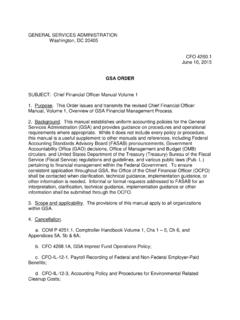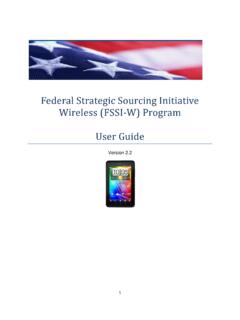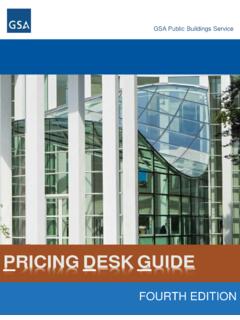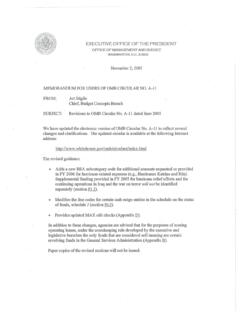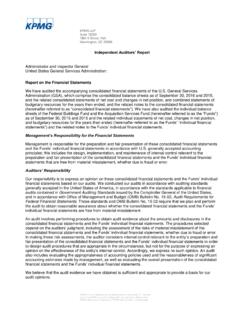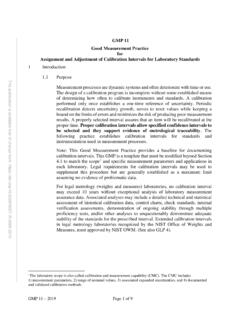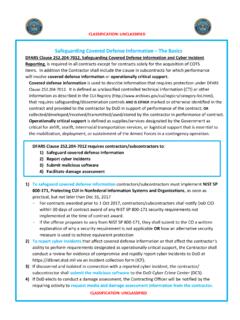Transcription of IT Security Procedural Guide: Identification and ...
1 Office of the Chief Information Security Officer IT Security Procedural guide : Identification and Authentication (IA) CIO-IT Security -01-01 Revision 6 March 20, 2019 CIO-IT Security -01-01, Revision 6 Identification and Authentication General Services Administration VERSION HISTORY/CHANGE RECORD Change Number Person Posting Change Change Reason for Change Page Number of Change Revision 1 - June 23, 2005 1 Scott/Heard Changes made throughout the document to reflect FISMA, NIST and GSA CIO P requirements. Updated to reflect and implement various FISMA, NIST and GSA CIO P requirements. Various 2 Scott/Heard Changes throughout the document to correspond with revisions made to CIO-IT Security -01-09, CIO-IT Security -01-03 and CIO-IT Security -01-04. Updated to reflect the correlation of the CIO-IT Security Guides; and to further express policy within them as stand-alone documents. Various Revision 2 - January 08, 2008 1 Berlas Changes made throughout the document to reflect FDCC password requirements.
2 OMB Memorandum M-07-11 mandates the implementation of FDCC configuration requirements. Various Revision 3 June 22, 2010 1 Berlas/Cook Changes made throughout the document to reflect updates in governing policy and procedures, including, NIST SP 800-53 rev3, HSPD-12, OMB e-Authentication, and FDCC password requirements. Updated to reflect and implement OMB, NIST, and GSA CIO P requirements. Various Revision 4 April 17, 2015 1 Graham Changes to the Revision number and date of the document. Updated Cover Page, Sections , 2-4, and Appendices to reflect CIO and GSA guidance. Updated sections to provide current references, current policy statements and methodologies. All 2 Heard Included references from the IT Security Program Plan. Various Various Revision 5 May 5, 2017 1 Feliksa/Dean/Klemens Changes made throughout the document to align with current OMB, NIST, and GSA policies. Updated to align with the current version of GSA CIO , format to latest guide structure and style, revise guidance to current GSA policies and processes.
3 Throughout Revision 6 March 20, 2019 1 Dean/ Klemens Updated format and NIST SP 800-53 control parameters, added a section on SCRM, included EO 13800 and NIST Cybersecurity Framework. Biennial update. Throughout CIO-IT Security -01-01, Revision 6 Identification and Authentication General Services Administration Approval IT Security Procedural guide : Identification and Authentication, CIO-IT Security -01-01, Revision 6 is hereby approved for distribution. 3/20/2019 XBo BerlasBo BerlasActing GSA Chief Information Security OfficerSigned by: General Services Administration Contact: GSA Office of the Chief Information Security Officer (OCISO), Policy and Compliance Division (ISP), at CIO-IT Security -01-01, Revision 6 Identification and Authentication General Services Administration i Table of Contents 1 Introduction ..1 Purpose .. 2 Scope .. 2 Policy .. 3 References .. 5 2 Roles and Responsibilities ..7 Authorizing Official (AO).
4 7 Information Systems Security Manager (ISSM) .. 7 Information System Security Officer (ISSO) .. 7 System Owners .. 7 Data Owners .. 8 Authorized Users of IT Resources .. 8 System/Network Administrators .. 8 Supervisors .. 9 3 Implementation Guidance for IA Controls .. 10 IA-1: Identification and Authentication Policy and Procedures .. 10 IA-2: Identification and Authentication (Organizational Users) .. 11 IA-3: Device Identification and Authentication .. 14 IA-4: Identifier Management .. 14 IA-5: Authenticator Management .. 16 IA-6: Authenticator Feedback .. 21 IA-7: Cryptographic Module Authentication .. 21 IA-8 Identification and Authentication (Non-Organizational Users) .. 22 4 Identification and Authentication and Supply Chain Risk Management .. 23 IA-1 Identification and Authentication Policy and Procedures (ICT SCRM).. 23 IA-2 Identification and Authentication (Organizational Users) (ICT SCRM) .. 24 IA-4 Identifier Management (ICT SCRM).
5 24 IA-5 Authenticator Management (ICT SCRM) .. 25 IA-8 Identification and Authentication (Non-Organizational Users) (ICT SCRM) .. 25 Appendix A: Definitions .. 26 Table 1-1: NIST SP 800-53 Control to CSF Mapping ..2 Note: I&A and IA are used throughout this guide . IA is used when referring to NIST SP 800-53 Security controls or in relation to those controls. I&A is used as an acronym for Identification and authentication and when referring to processes, features, or mechanisms used to implement user Identification and user authentication. CIO-IT Security -01-01, Revision 6 Identification and Authentication General Services Administration 1 1 Introduction Identification and Authentication (I&A) is critical to securing agency information and information technology (IT) assets. Account Management deals with the creation and management of information systems accounts, I&A focuses on assignment and management of accounts to users and devices. An effective I&A program is often the first line of defense for protecting IT assets and data in that it provides a secure process for the assignment and management of user and device accounts as well as establishing strong password policies to protect General Services Administration (GSA) information systems from unauthorized access and use.
6 The mechanisms associated with I&A, when effectively applied, ensure that individuals or devices accessing or connecting to GSA s IT resources are indeed who they represent themselves to be. The most commonly known I&A mechanisms are usernames and passwords. GSA has implemented multi-factor authentication (MFA) with smartcards at the desktop as required by GSA Order CIO , GSA Information Technology (IT) Security Policy. The use of MFA and to a lesser extent, unique account names combined with strong, well-constructed passwords help to ensure the confidentiality of GSA information and the integrity of IT resources. The I&A principles and practices described in this guide and guidance regarding the IA control family are based on the following documents: National Institute of Standards and Technology (NIST) Special Publication (SP) 800-53, Revision 4, Security and Privacy Controls for Federal Information Systems and Organizations NIST SP 800-63-3, Digital Identity Guidelines NIST SP 800-63A, Digital Identity Guidelines: Enrollment and Identity Proofing NIST SP 800-63B, Digital Identity Guidelines: Authentication and Lifecycle Management NIST SP 800-63C, Digital Identity Guidelines: Federation and Assertions Every GSA IT system must follow the IA practices identified in this guide .
7 Any deviations from the Security requirements established in GSA Order CIO must be coordinated by the Information Systems Security Officer (ISSO) through the appropriate Information Systems Security Manager (ISSM) and authorized by the Authorizing Official (AO). Any deviations, exceptions, or other conditions not following GSA policies and standards must be submitted using the Security Deviation Request Google Form. Deviations must also be documented using the Acceptance of Risk (AoR) process defined in GSA CIO-IT Security -06-30, Managing Enterprise Risk, including a date of resolution to comply. Executive Order (EO) 13800, Presidential Executive Order on Strengthening the Cybersecurity of Federal Networks and Critical Infrastructure requires all agencies to use The Framework for Improving Critical Infrastructure Cybersecurity (the Framework) developed by the National Institute of Standards and Technology (NIST) or any successor document to manage the CIO-IT Security -01-01, Revision 6 Identification and Authentication General Services Administration 2 agency s cybersecurity risk.
8 This NIST document is commonly referred to as the Cybersecurity Framework (CSF). The CSF focuses on using business drivers to guide cybersecurity activities and considering cybersecurity risks as part of the organization s risk management processes. The core of the CSF consists of five concurrent and continuous Functions Identify (ID), Protect (PR), Detect (DE), Respond (RS), and Recover (RC). The CSF complements, and does not replace, an organization s risk management process and cybersecurity program. GSA uses NIST s Risk Management Framework from NIST SP 800-37, Revision 1, guide for Applying the Risk Management Framework to Federal Information Systems: A Security Life Cycle Approach. Table 1-1 provides a mapping of the NIST SP 800-53 IA controls to CSF Category Unique Identifiers. The following CSF categories are aligned with NIST s IA controls. Identify Governance ( ) Protect Access Control ( ) Table 1-1: NIST SP 800-53 Control to CSF Mapping NIST SP 800-53 Control CSF Category Unique Identifier Codes IA-1 , , , , IA-2 , , IA-3 , IA-4 , , IA-5 , , IA-6 IA-7 IA-8 , , Purpose The purpose of this guide is to provide guidance for the IA Security controls identified in NIST SP 800-53 and I&A requirements specified in CIO This Procedural guide provides GSA Federal employees and contractors with significant Security responsibilities, as identified in CIO , and other IT personnel involved in implementing I&A mechanisms, the specific procedures and processes they are to follow for systems under their purview.
9 Scope The requirements outlined within this guide apply to all GSA Federal employees and contractors involved in I&A implementations for GSA information systems. All GSA systems must adhere to the requirements and guidance provided with regard to I&A features, mechanisms, and methods. CIO-IT Security -01-01, Revision 6 Identification and Authentication General Services Administration 3 Policy CIO Chapter 4, Policy for Protect Function, Section 1, Identity Management, Authentication and Access Control establishes the following policies for Identification and authentication required for GSA information systems. b. All users issued GFE are required to log into the workstation using a GSA issued [Personal Identity Verification] PIV credential. The following groups of users are exempt from this requirement: (1) A Federal employee on detail to GSA issued a PIV from the employee s assigned Agency. (2) Any employee or contractor expected to be employed for less than 180 days and not issued a PIV.
10 (3) Any person with a disability that does not allow the individual to utilize a PIV card and laptop. (4) Any user with a PIV that is lost, forgotten at home, or damaged in any way, may contact the IT Service Desk (ITSD) to request a temporary exception to the above requirement, not to exceed forty-five (45) days. c. Systems with users who are agency business partners or the general public, and who register or log into the system, must accept credentials issued by identity providers who have been certified by federally approved Trust Framework Providers. zz. All GSA systems must incorporate a proper user Identification and authentication methodology. Refer to the GSA CIO-IT Security -01-01 for additional details. aaa. User IDs shall be unique to each authorized user. bbb. Authentication schemes for all systems must utilize MFA using two or more types of identity credentials ( , passwords, SAML biometrics, tokens, smart cards, one time passwords) as approved by the AO and IAW the Security requirements in the subparagraphs of this paragraph.

